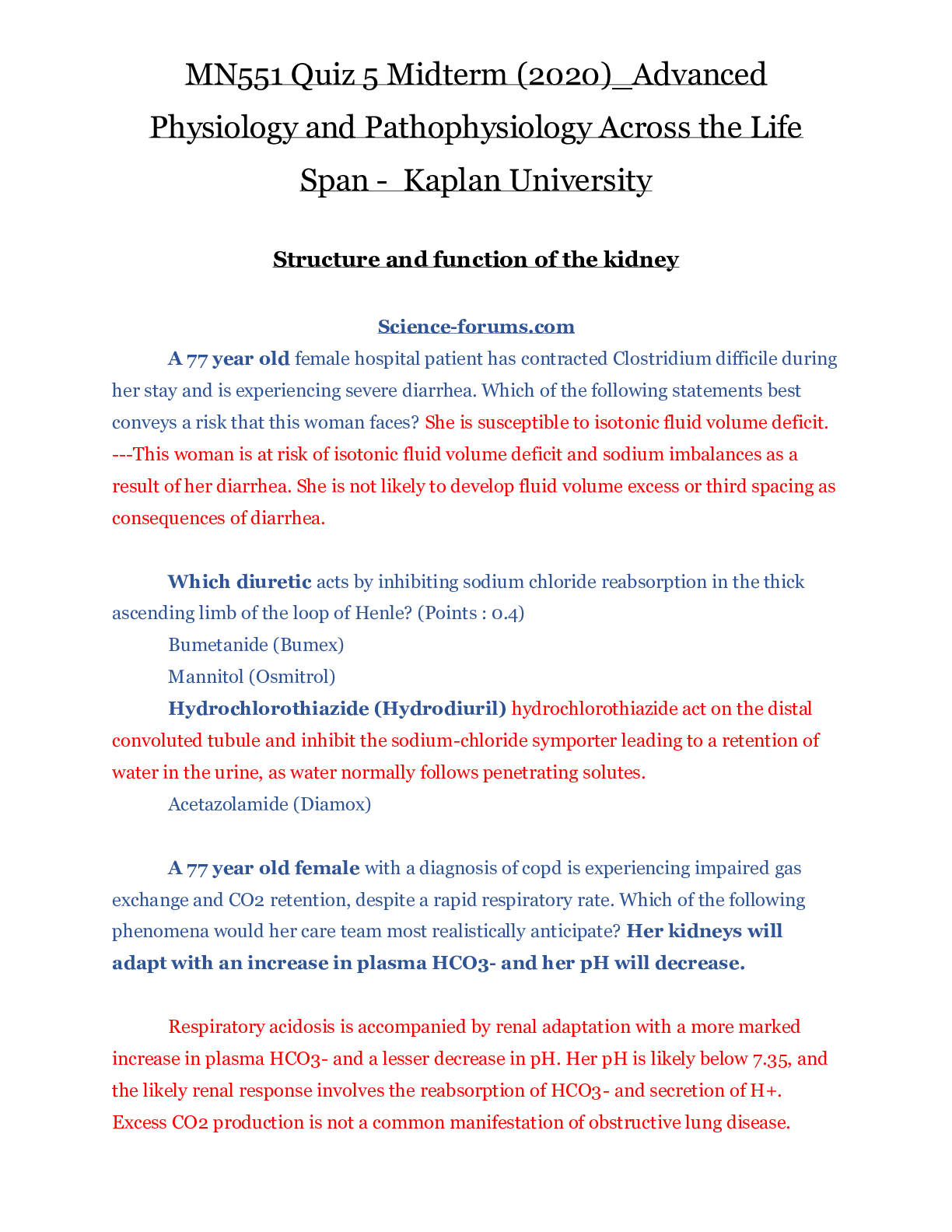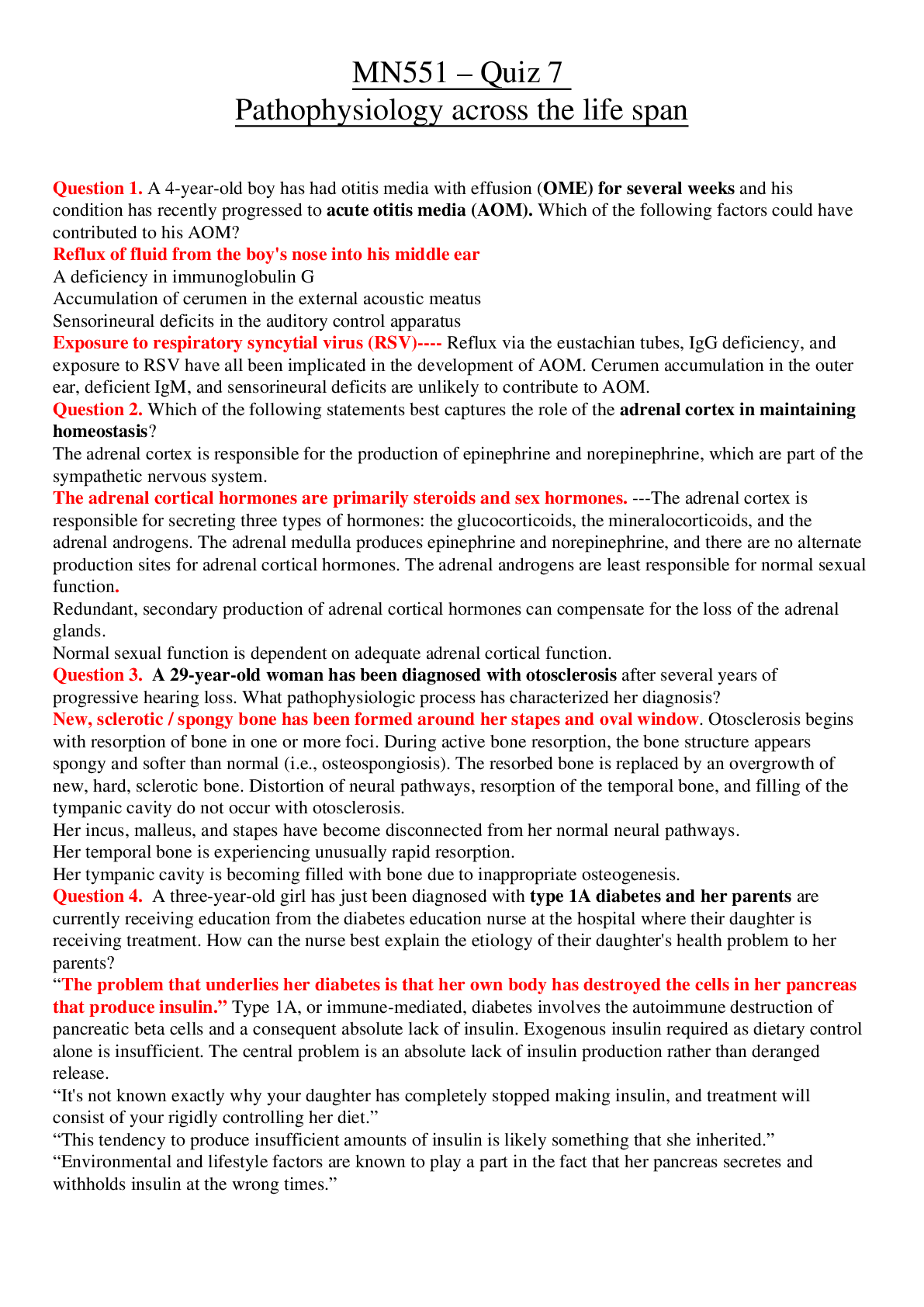*NURSING > EXAM > MN 551–Quiz 5_Advanced Physiology and Pathophysiology Across the Life Span_2020 | MN551–Quiz 5_2 (All)
MN 551–Quiz 5_Advanced Physiology and Pathophysiology Across the Life Span_2020 | MN551–Quiz 5_2020 - Kaplan University
Document Content and Description Below
MN551–Quiz 5 Advanced Physiology and Pathophysiology Across the Life Span Midterm Structure and function of the kidney Science-forums.com A 77 year old female hospital patient has contrac... ted Clostridium difficile during her stay and is experiencing severe diarrhea. Which of the following statements best conveys a risk that this woman faces? She is susceptible to isotonic fluid volume deficit. ---This woman is at risk of isotonic fluid volume deficit and sodium imbalances as a result of her diarrhea. She is not likely to develop fluid volume excess or third spacing as consequences of diarrhea. Which diuretic acts by inhibiting sodium chloride reabsorption in the thick ascending limb of the loop of Henle? (Points : 0.4) Bumetanide (Bumex) Mannitol (Osmitrol) Hydrochlorothiazide (Hydrodiuril) hydrochlorothiazide act on the distal convoluted tubule and inhibit the sodium-chloride symporter leading to a retention of water in the urine, as water normally follows penetrating solutes. Acetazolamide (Diamox) A 77 year old female with a diagnosis of copd is experiencing impaired gas exchange and CO2 retention, despite a rapid respiratory rate. Which of the following phenomena would her care team most realistically anticipate? Her kidneys will adapt with an increase in plasma HCO3- and her pH will decrease. Respiratory acidosis is accompanied by renal adaptation with a more marked increase in plasma HCO3- and a lesser decrease in pH. Her pH is likely below 7.35, and the likely renal response involves the reabsorption of HCO3- and secretion of H+. Excess CO2 production is not a common manifestation of obstructive lung disease. A 68 year old woman with a new onset a vascular dementia has recently begun retaining urine. Which of the following physiological phenomena would her care providers most realistically expect to be currently occurring as a result of her urinary retention? Hypertrophy of the bladder muscle and increased bladder wall thickness. Early accompaniments to urinary retention include hypertrophy of the bladder muscle and increased thickness of the bladder wall. Renal effects are unlikely, and decompensation and loss of contraction power are most often later rather than early effects. An 87 year old male resident has been consistenly continent of urine until the last several weeks. Which of the following action by the care providers at the facility is the most likely priority? Physical exam The priority in the treatment of incontinence in the elderly is an acknowledgement that it is not an inevitability and that the exact causes should and most often can be identified. This identification by way of history-taking and examination would supersede teaching about protective devices or exercis Question 2.2. At which of the following locations in the nephron would a nurse practitioner first expect blood to be largely free of plasma proteins? (Points : 0.4) Proximal convoluted tubule Bowman space Active filtration occurs when the whole blood enters via the afferent arteriole in to the glomerular capillaries, and the blood is then filtered into the Bowman space, removing plasma proteins. The filtrate that enters the proximal convoluted tubule and the loop of Henle is already free of plasma proteins Loop of Henle Afferent arteriole Question 3.3. A 14-year-old boy who appears to be intoxicated is brought to the emergency department by ambulance. The EMTs report that the boy has denied consuming anything out of the ordinary, but an open antifreeze container was found in the boy's room. Which of the following is likely to be used to treat the patient's symptoms? (Points : 0.4) Gastric lavage Syrup of ipecac Fomepizole - Ethylene glycol is found in products ranging from antifreeze and deicing solutions to carpet and fabric cleaners. It tastes sweet and is intoxicating—the factors that contribute to its abuse potential. A lethal dose is approximately 100 mL. It is rapidly absorbed from the intestine, making treatment with either gastric lavage or syrup of ipecac ineffective. Fomepizole, with specific indications for ethylene glycol poisoning, was recently approved by the U.S. Food and Drug Administration. Sodium bicarbonate Question 4.4. A 4-year-old boy who has been deaf since birth and has bilateral cataracts has been brought to the emergency department by his mother because she noticed blood in the toilet after he last voided. Urinalysis confirms heavy microscopic hematuria as well as proteinuria. What will the care team's initial differential diagnosis most likely be? (Points : 0.4) Alport syndrome-Heavy microscopic hematuria, proteinuria, and sensorineural deafness and eye disorders are characteristic of Alport syndrome. This symptomatology is less characteristic of systemic lupus erythematosus glomerulonephritis, Henoch-Schönlein purpura nephritis, or immunoglobulin A nephropathy. Systemic lupus erythematosus glomerulonephritis Henoch-Schonlein purpura nephritis Immunoglobulin A nephropathy Question 5.5. A patient is brought to the emergency department with complaints of shortness of breath. Assessment reveals a full, bounding pulse, severe edema, and audible crackles in the lower lung fields bilaterally. What is the patient's most likely diagnosis? (Points : 0.4) Hyponatremia Fluid volume excess - Peripheral and pulmonary edema as well as a bounding pulse and dyspnea are indicators of fluid volume overload. Hypocalcemia Hyperkalemia Question 6.6. Which of the following data would a clinician consider to be most indicative of acute renal failure?(Points : 0.4) Alterations in blood pH, peripheral edema Increased nitrogenous waste levels, decreased glomerular filtration rate (GFR) the hallmark of acute renal injury is azotemia, an accumulation of nitrogenous wastes such as creatinine, urea nitrogen, and uric acid, plus a decrease in the GFR of the kidneys. While pH alterations, edema, electrolyte imbalances, and decreased urine output may accompany acute renal failure, they are all potentially attributable to other pathologies. Creatinine, GFR, and BUN would unlikely rise during renal failure. Decreased serum creatinine and blood urea nitrogen (BUN), decreased potassium and calcium levels Decreased urine output, hematuria, increased GFR Question 7.7. Which of the following substances is most likely to be reabsorbed in the tubular segments of the nephron using passive transport mechanisms? (Points : 0.4) Water Water is passively reabsorbed across tubular epithelial membranes, while ions like sodium, phosphate, and calcium necessitate active transport. Sodium Phosphate Calcium Question 8.8. A 60-year-old man has been diagnosed with renal calculi after repeated episodes of excruciating flank pain in recent weeks. The man states, “I don't know how this could happen to me, since I'm so careful about eating a healthy diet.” What is the most appropriate response to the man's statement? (Points : 0.4) “Your diet may have played a part in this, but in fact genetics is likely primarily to blame.” “What you eat can influence your risk of stone formation, but many other factors like hormones and your metabolism are involved.” Renal calculi have a complex etiology that includes diet, but also many other metabolic and endocrine factors, among others. Genetics are not identified as a contributor, and mineral intake is not likely to be the sole factor. Stone formation is normally unilateral. “You likely don't need to change your diet, but now that you have stones in one kidney, you're at very high risk of growing them in the other kidney.” “Your diet might be normally healthy, but high intake of normally beneficial minerals like calcium and magnesium can lead to stones.” Question 9.9. An 82-year-old resident of a long-term care facility with a recent history of repeated urinary tract infections and restlessness is suspected of having urinary retention. Which of the following actions by the care team is most appropriate? (Points : 0.4) Uroflowmetry to determine to rate of the patient's urine flow Ultrasound bladder scanning to determine the residual volume of urine after voiding- Ultrasound bladder scanning yields a fast and noninvasive indication of whether or not an individual is adequately emptying his or her bladder with each void. Uroflowmetry would be less indicative of whether the man is retaining, and renal ultrasound would address deficits in urine production rather than bladder emptying. Urinalysis would be useful in the diagnosis of infections and/or renal issues more than deficiencies in bladder emptying. Renal ultrasound aimed at identifying acute or chronic kidney disease Urinalysis focusing on the presence or absence of microorganisms, blood, or white cells in the man's urine Question 10.10. A 34-year-old male patient has diagnoses of liver failure, ascites, and hepatic encephalopathy secondary to alcohol abuse. The patient's family is questioning the care team about why his abdomen is so large even though he is undernourished and emaciated. Which of the following statements most accurately underlies the explanation that a member of the care team would provide to the family? (Points : 0.4) An inordinate amount of interstitial fluid is accumulating in the patient's abdomen. The transcellular component of the intracellular fluid compartment contains far more fluid than normal. The normally small transcellular fluid compartment, or third space, is becoming enlarged. Ascites is characterized by an accumulation of fluid in the transcellular component of the ECF, not ICF. The fluid is not categorized as belonging to the plasma component of the ECF Gravity-dependent plasma is accumulating in the patient's peritoneal cavity. Question 11.11. A pediatric unit will be receiving from a rural medical outpost a patient transfer of an 8-day-old infant with a suspected congenital renal disorder. Which of the following possibilities is the care team most likely to be able to rule out early? (Points : 0.4) One of the infant's kidneys may have failed to develop to a normal size. The kidneys may be misshapen and have cysts. The upper or lower poles of the two kidneys may be fused. Renal cell carcinoma may be present. Question 12.12. A 22-year-old female with a history of intermittent flank pain, repeated UTIs, and hematuria has been diagnosed with autosomal dominant polycystic kidney disease (ADPKD). Which of the following phenomena has most likely contributed to the development of her health problem? (Points : 0.4) UTIs coupled with an impaired immune response have caused her ADPKD. She has inherited a tendency for epithelial cell in her tubules to proliferate inappropriately. ADPKD is an inherited condition, and the etiology is thought to involve cysts arising in segments of the renal tubules from a few epithelial cells that proliferate abnormally. UTIs are consequent, not causative, of the condition. Severe hypertension and portal hypertension are more commonly associated with ARPKD than ADPKD. Kidneys are typically oversized in ADPKD, and renal calculi are not noted sequelae. Severe hypertension and portal hypertension are likely precursors. She has inherited undersized kidneys that are prone to calculi formation. Question 13.13. A patient with poorly controlled diabetes mellitus presents to the emergency department with suspected ketoacidosis. Which of the following diagnostic results would be most likely to confirm this diagnosis?(Points : 0.4) Low O2 levels, increased anion gap, base excess High ammonia levels, decreased anion gap, high potassium Increased CO2, increased anion gap, base deficit -Increased CO2 levels, an increased anion gap, and a base deficit are aIl associated with an acidotic state. Base excess, low oxygen, high potassium, high ammonia, and decreased anion gap would not suggest acidosis. Decreased CO2, decreased anion gap Question 14.14. A 55-year-old man has made an appointment to see his nurse practitioner because he has been awakening three to four times nightly to void and often has a sudden need to void with little warning during the day. What is the man's most likely diagnosis and possible underlying pathophysiologic problem? (Points : 0.4) Stress incontinence due to damage to CNS inhibitory pathways Overactive bladder that may result from both neurogenic and myogenic sources - The man's complaints are typical of overactive bladder, a condition that can result from the interaction of both the nervous control of bladder emptying and the muscles of the bladder itself. His symptoms are not characteristic of stress incontinence, and when intravesical pressure exceeds, urethral pressure overflow incontinence results. The angle between the bladder and the posterior proximal urethra is more commonly a factor in the continence of females. Overactive bladder due to intravesical pressure exceeding urethral pressure Overflow incontinence that can result from displacement of the angle between the bladder and the posterior proximal urethra Question 15.15. Which of the following patients on a medical unit of a hospital is most likely to be experiencing health problems that may be attributable to kidney disease? (Points : 0.4) An 81-year-old female patient with osteoporosis and anemia The kidneys play central roles in both vitamin D activation and regulation of red blood cell production, deficiencies of which may result in osteoporosis and anemia, respectively. BPH, stroke, and infection are less likely to result from kidney disease. A 77-year-old patient with urinary retention due to benign prostatic hyperplasia (BPH) A 55-year-old woman with a recent stroke secondary to long-standing hypertension A 60-year-old man with a systemic fungal infection requiring intravenous antibiotics Question 16.16. Following several days in an acidotic state, a hospital patient has returned to the desired pH. Which of the following processes could have contributed to the resolution of the patient's health problem?(Points : 0.4) Exchange of Na+ and H+ ions Selective renal secretion and reabsorption of CO2 Phosphate and ammonia buffer systems in the renal tubules- The phosphate and ammonia buffer systems are secondary, but important, processes that contribute to the maintenance of appropriate pH. The kidneys must reabsorb nearly all the body's stores of HCO3- to maintain homeostasis, and they are not involved in CO2 control. Hydrogen-potassium exchange, not hydrogen-sodium exchange, is a component of acid-base control. Excretion of HCO3– by the kidneys Question 17.17. Which of the following patients would be considered to have a significant risk of developing the prerenal form of acute renal failure? A 22-year-old male who has lost a large amount of blood following a workplace injury A 41-year-old female who is admitted for intravenous antibiotic treatment of pyelonephritis A 79-year-old male with diagnoses of poorly controlled diabetes mellitus and congestive heart failure Hemorrhage, heart failure, and dehydration (hypovolemia) are all noted contributors to prerenal failure. Pyelonephritis and damage from nephrotoxic drugs would more likely result in intrinsic renal failure, while BPH is postrenal in nature. A 20-year-old male who is admitted for treatment of an overdose of a nephrotoxic drug A 68-year-old male with a diagnosis of benign prostatic hyperplasia (BPH) An 80-year-old female who has been admitted for treatment of dehydration, hyponatremia, and malnutrition Question 18.18. A 25-year-old Asian American man arrives at the emergency department in a panic. Except for a bout with bronchitis a week earlier, he has been healthy his entire life; today he has blood in his urine. What is the most likely cause of his hematuria and how should it be treated? (Points : 0.4) His Goodpasture syndrome should be treated with plasmapheresis and immunosuppressive therapy. His membranous glomerulonephritis should be treated with corticosteroids. His immunoglobulin A (IgA) nephropathy has no known effective treatments. Immunoglobulin A (IgA) nephropathy (Buerger disease) is a primary glomerulonephritis characterized by the presence of glomerular IgA immune complex deposits. It can occur at any age, but most commonly occurs with clinical onset in the second and third decades of life. It is more common in males than in females and is the most common cause of glomerular nephritis in Asians. There is no satisfactory treatment for IgA nephropathy. Goodpasture syndrome is a form of glomerulonephritis; treatment includes plasmapheresis to remove circulating anti-GBM antibodies and immunosuppressive therapy to inhibit antibody production. Membranous glomerulonephritis is the most common cause of primary nephrosis in adults, most commonly those in their sixth or seventh decade. It is treated with corticosteroids. In nodular glomerulosclerosis, also known as Kimmelstiel-Wilson syndrome, there is nodular deposition of hyaline in the mesangial portion of the glomerulus. As the sclerotic process progresses in the diffuse and nodular forms of glomerulosclerosis in many cases, early changes in glomerular function can be reversed by careful control of blood glucose levels. Control of high blood pressure and smoking cessation are recommended as primary and secondary prevention strategies in persons with diabetes. His Kimmelstiel-Wilson syndrome should be treated with control of high blood pressure and smoking cessation. Question 19.19. An 81-year-old female has long-standing hypocalcemia secondary to kidney disease and will shortly be moving into an assisted living facility from her own apartment. Which of the following findings should staff at the facility be instructed to observe for? (Points : 0.4) Loss of appetite and complaints of nausea Muscular spasms and complaints of cramps - Muscular spasms and cramping are common manifestations of low serum calcium. Polydipsia, polyuria, anorexia, lethargy, and stupor are associated with hypercalcemia High fluid intake and urine output Lethargy and stupor Question 20.20. A nurse educator is orientating new nurses to a renal unit of a hospital. Which of the following teaching points should the nurse include as part of a review of normal glomerular function? (Points : 0.4) “Nephrons are delicate structures that cannot endure the high pressure that exists in capillary beds elsewhere in the body.” “Glomerular filtrate is very similar in composition to blood plasma found elsewhere in circulation.” Because filtration achieves the removal of nearly all blood proteins, the glomerular filtrate is nearly identical to plasma. Nephrons require high pressure to function, and dilation decreases the glomerular filtration rate. The glomerulus is located between two arterioles “Dilation of the afferent arteriole allows more blood into the nephron and increases the glomerular filtration rate.” “The glomerulus is located between an arteriole and a venule that work together to regulate blood flow.” Question 21.21. Which of the following individuals is at the highest risk for developing a urinary tract infection (UTI)? (Points : 0.4) A 60-year-old man with a history of cardiovascular disease who is recovering in the hospital from a coronary artery bypass graft A 66-year-old man undergoing dialysis for the treatment of chronic renal failure secondary to hypertension A 38-year-old man with high urine output due to antidiuretic hormone insufficiency A 30-year-old obese woman with poorly controlled diabetes mellitus - Young women as well as persons with diabetes are at high risk of UTIs. Neither postsurgical recovery nor renal failure is necessarily a direct risk for UTI development, and high urine output would prevent decrease rather than increase in UTI risk. Question 22.22. A 61-year-old woman who has had an upper respiratory infection for several weeks has presented to her nurse practitioner with complaints of a recent onset of urinary retention. She reveals to her nurse practitioner that she has been taking over-the-counter cold medications at higher than the suggested dose for the past two weeks. Which of the following phenomena will her nurse practitioner most likely suspect is contributing to her urinary retention? (Points : 0.4) Cholinergic actions of the cold medicine are triggering internal and external sphincter contraction. Antihistamine effects inhibit communication between the pons and the thoracolumbar cord. The anticholinergic effects of the medication are impairing normal bladder function. - Many over-the-counter cold medications have an anticholinergic effect that interferes with normal bladder emptying. These effects on micturition are not a result of cholinergic actions or miscommunication between the pontine micturition center and the spinal cord. Stimulation of the parasympathetic nervous system would tend to increase rather than decrease bladder emptying. Over-the-counter medications such as cold medicine stimulate the parasympathetic nervous system and inhibit bladder emptying. Question 23.23. Which of the following individuals are displaying identified risk factors for the development of lower urinary tract obstruction? (Points : 0.4) A 32-year-old woman who had a healthy delivery of her third child 4 months ago A 68-year-old man who has been diagnosed with benign prostatic hyperplasia (BPH) A 55-year-old man with diabetes who is receiving diuretic medications for the treatment of hypertension A 30-year-old woman who has been diagnosed with gonorrhea A 74-year-old woman who has developed a lower bowel obstruction following several weeks of chronic constipation A 20-year-old man who has spina bifida and consequent impaired mobility Question 24.24. A 51-year-old woman diagnosed with multiple sclerosis (MS) five months prior is distressed that she has had several recent episodes of urinary incontinence. She has asked her nurse practitioner why this is the case. Which of the following statements best captures the facts that would underlie the nurse's response to the patient? (Points : 0.4) Neurologic diseases like MS often result in flaccid bladder dysfunction. She may be unable to sense her bladder filling as a result of her MS. MS may result in neurogenic bladder characterized by an inability to sense filling and consequent incontinence. She is not demonstrating the signs of a flaccid bladder, and lesions to the basal ganglia or extrapyramidal tract are associated with Parkinson disease, not MS. Her disease is unlikely to directly reduce bladder volume. Lesions of the basal ganglia or extrapyramidal tract associated with MS inhibit detrusor contraction. Pathologic reductions in bladder volume brought on by MS necessitate frequent micturition. Question 25.25. Which of the following individuals would be considered to be at risk for the development of edema? (Points : 0.4) An 81-year-old man with right-sided heart failure and hypothyroidism - Right-sided heart failure, burns, and low levels of plasma proteins are all associated with the development of edema. Diabetes and GI bleeds are not identified as contributors to edema A 60-year-old obese female with a diagnosis of poorly controlled diabetes mellitus A 34-year-old industrial worker who has suffered extensive burns in a job-related accident A 77-year-old woman who has an active gastrointestinal bleed and consequent anemia A 22-year-old female with hypoalbuminemia secondary to malnutrition and anorexia nervosa Which of the following data would a clinician consider to be most indicative of acute renal failure? Increased nitrogenous waste levels; decreased glomerular filtration rate (GFR) The hallmark of acute renal injury is azotemia, an accumulation of nitrogenous wastes such as creatinine, urea nitrogen, and uric acid, plus a decrease in the GFR of the kidneys. While pH alterations, edema, electrolyte imbalances, and decreased urine output may accompany acute renal failure, they are all potentially attributable to other pathologies. Creatinine, GFR, and BUN would unlikely rise during renal failure [Show More]
Last updated: 1 year ago
Preview 1 out of 13 pages
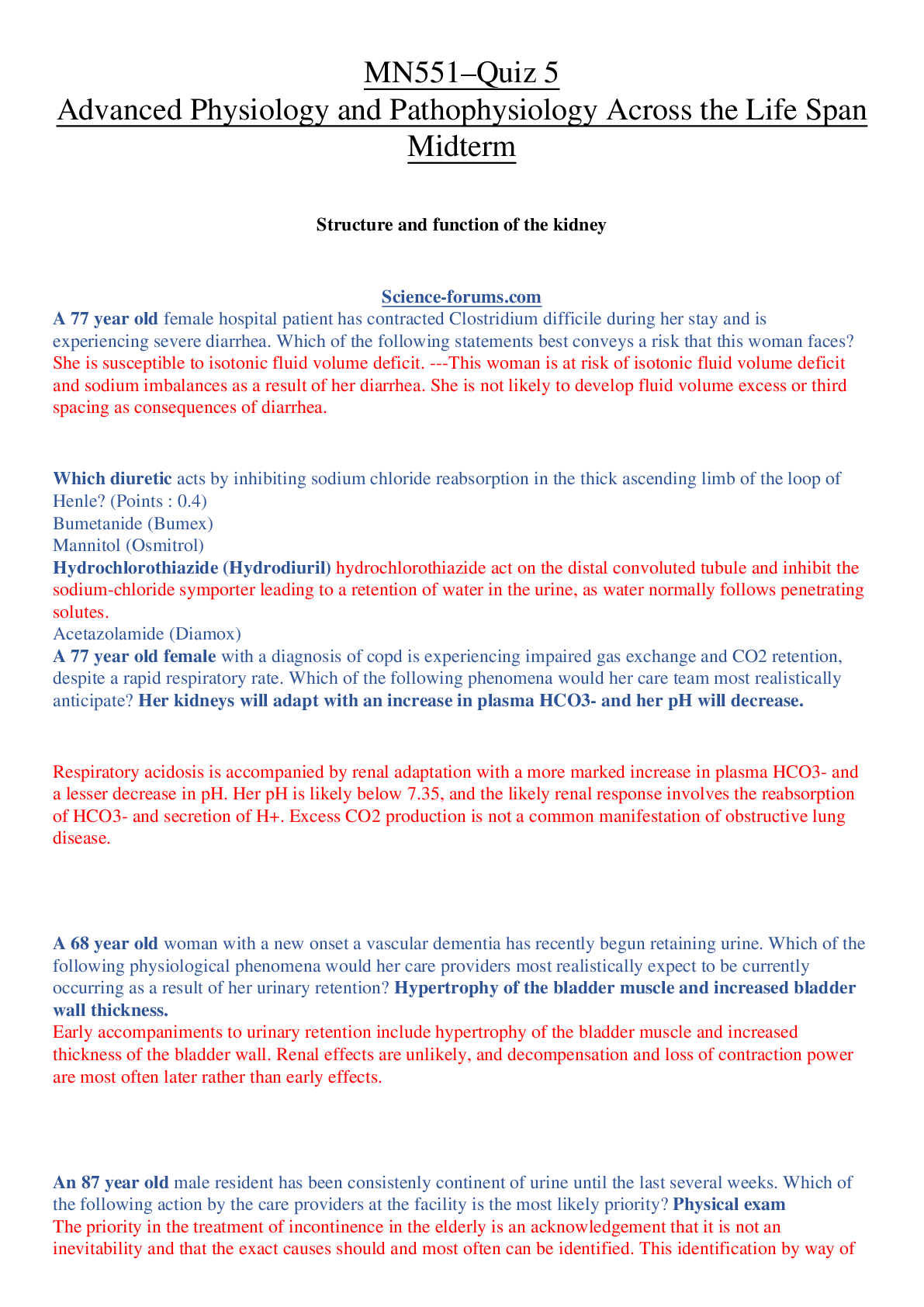
Reviews( 0 )
Document information
Connected school, study & course
About the document
Uploaded On
Jun 13, 2020
Number of pages
13
Written in
Additional information
This document has been written for:
Uploaded
Jun 13, 2020
Downloads
0
Views
41


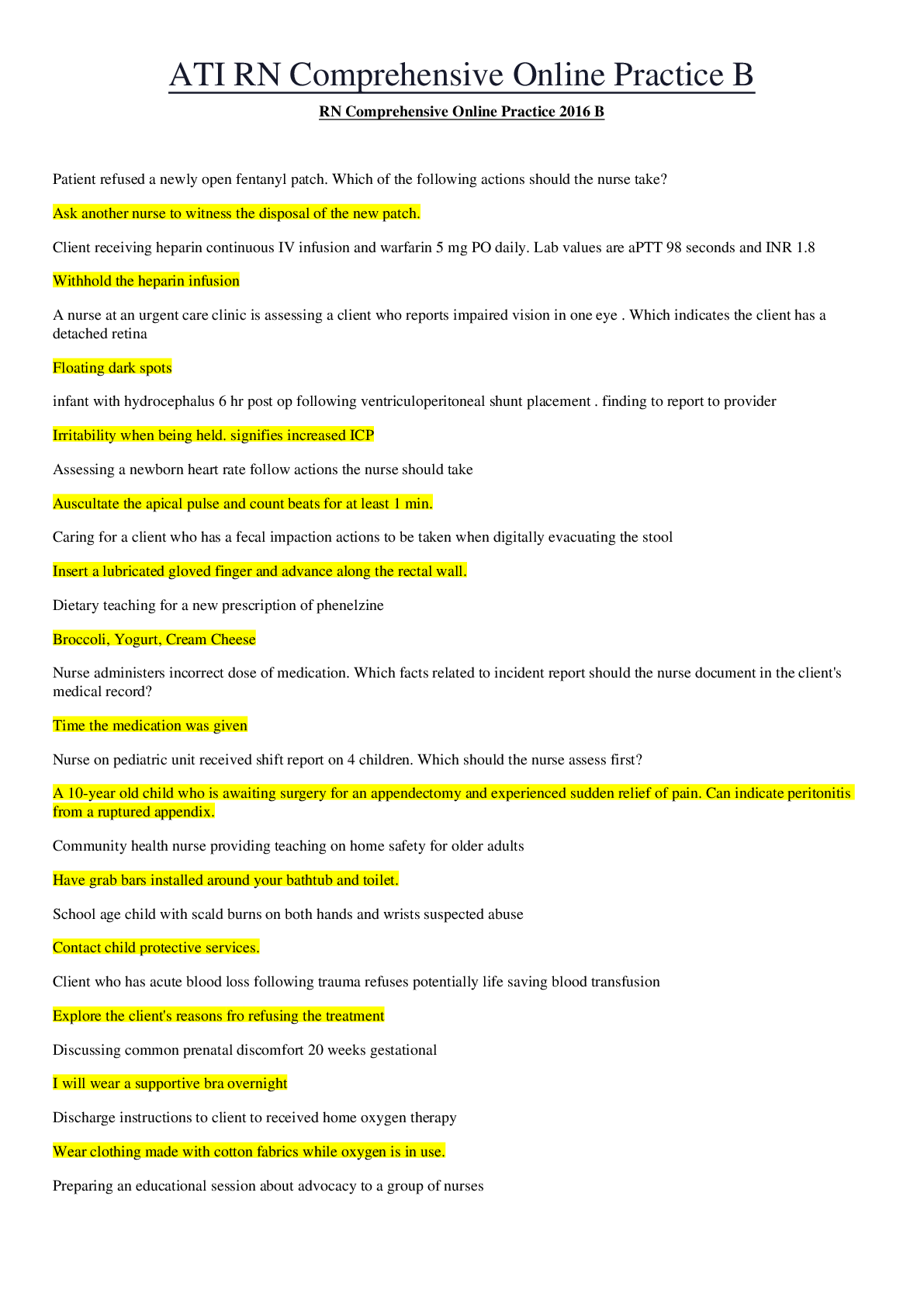
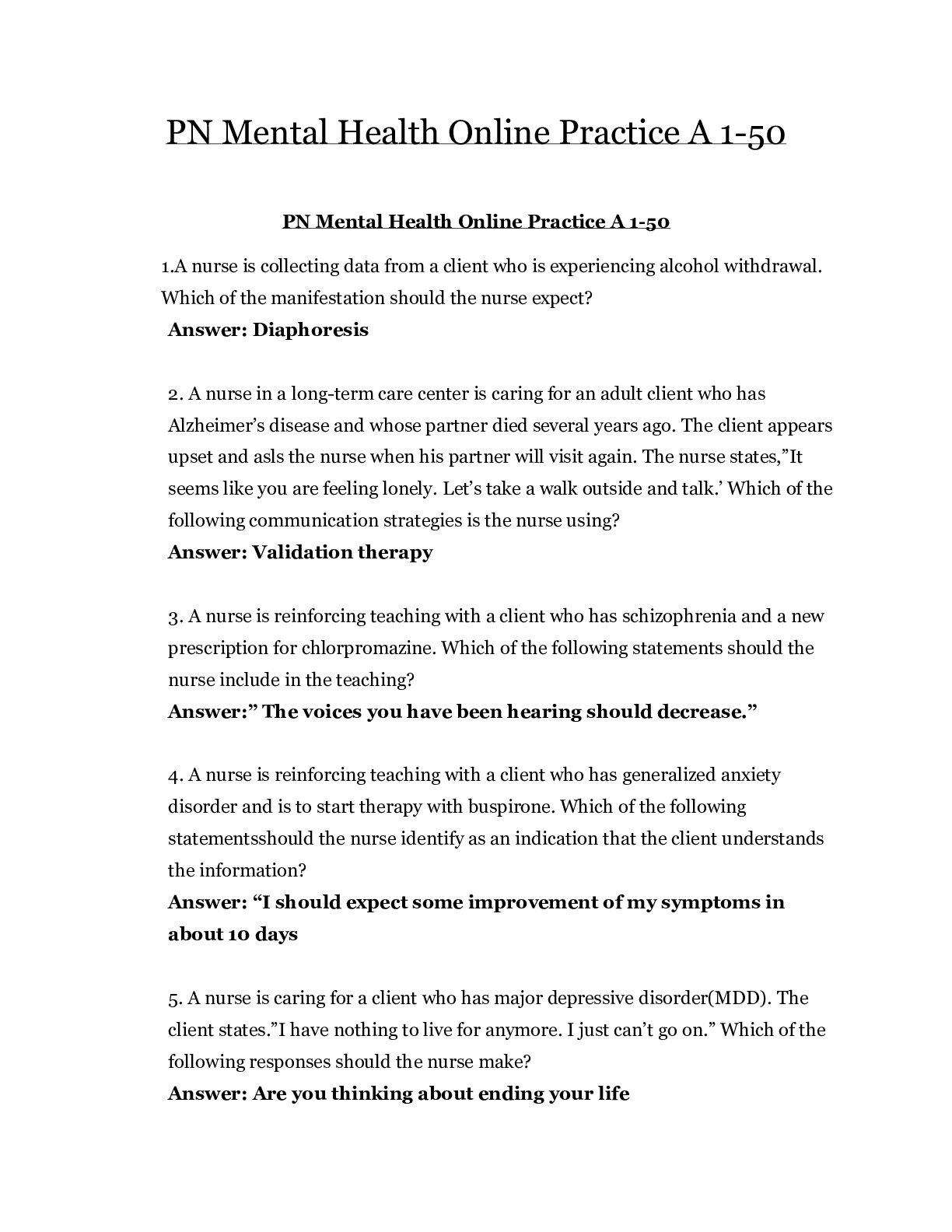
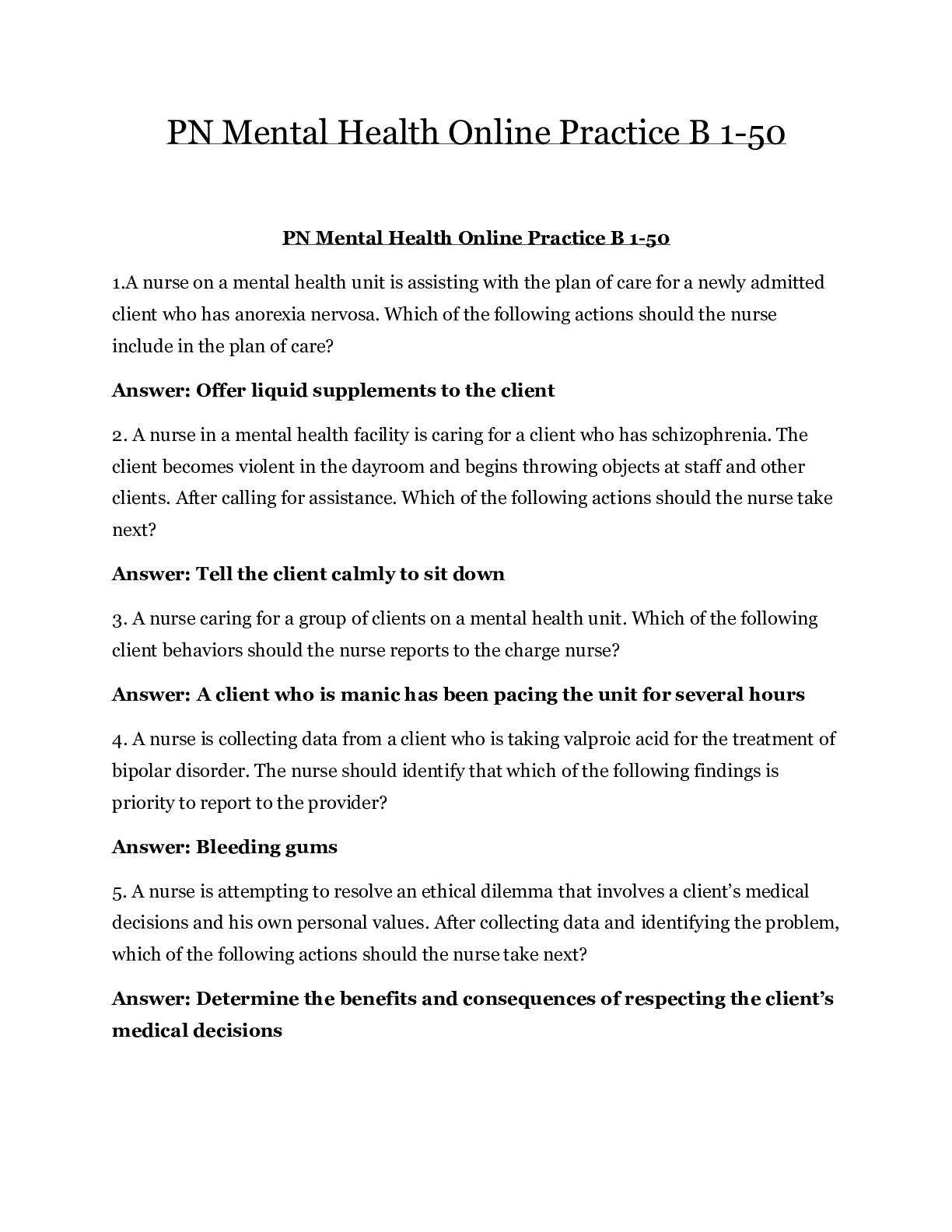
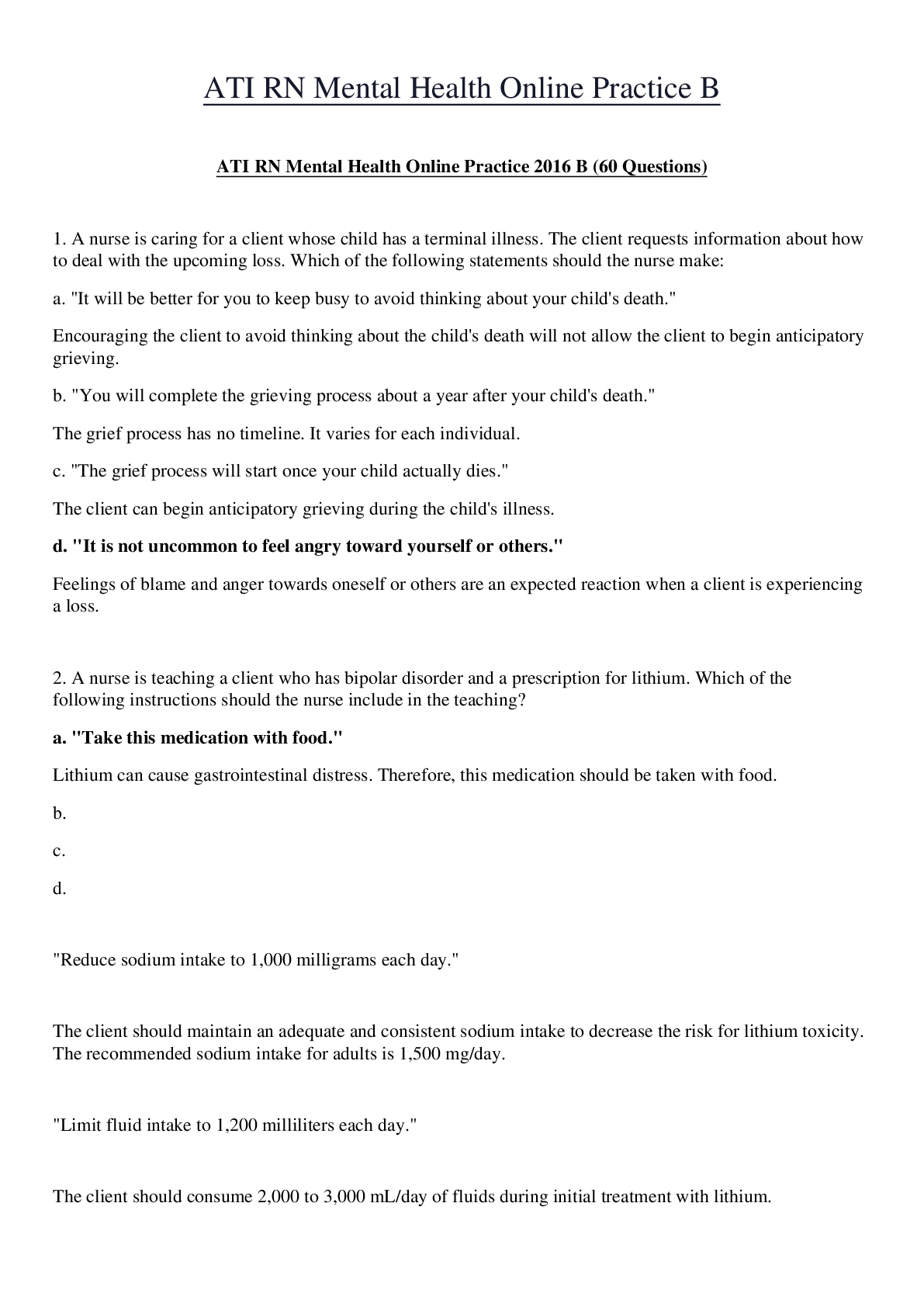


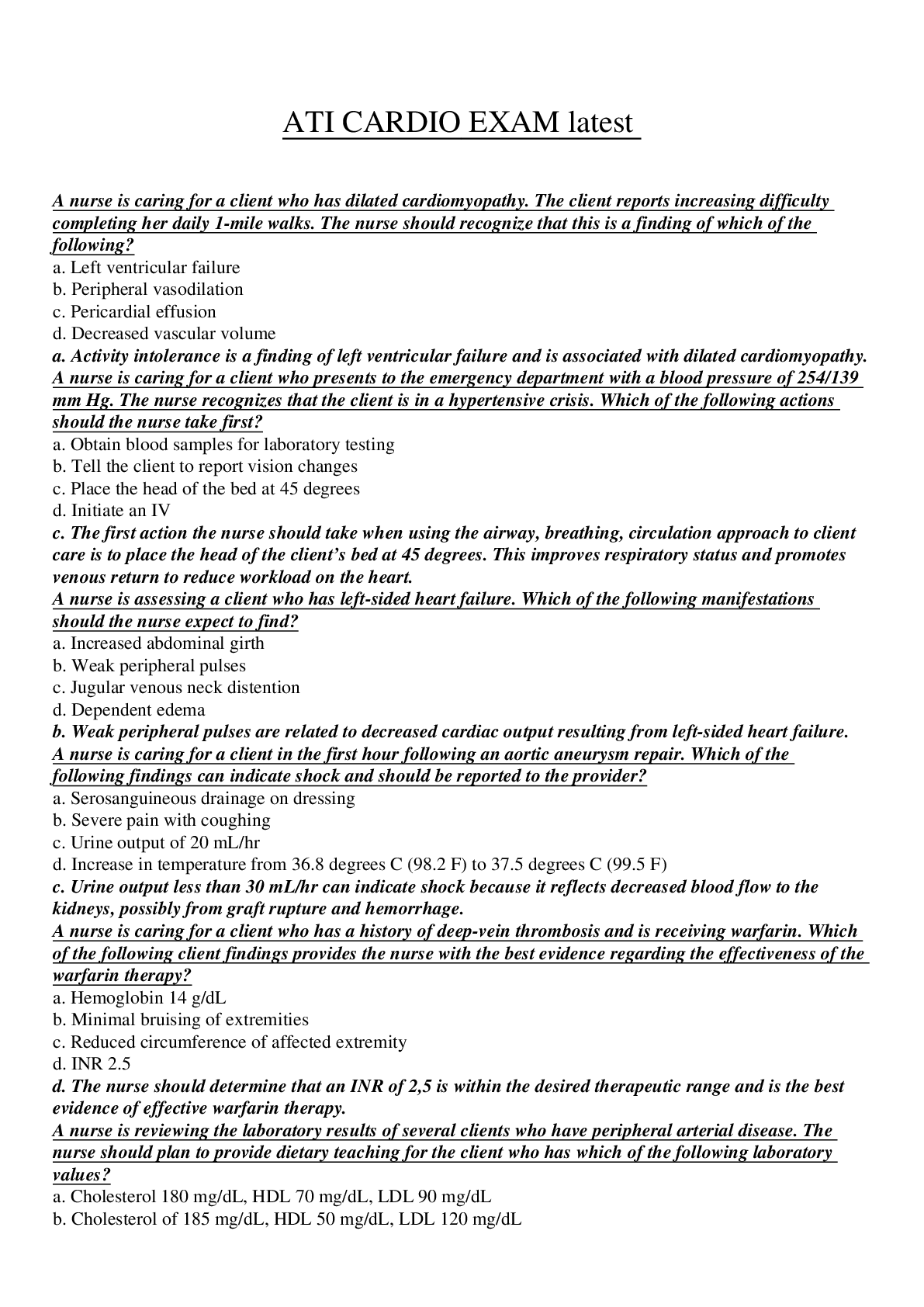
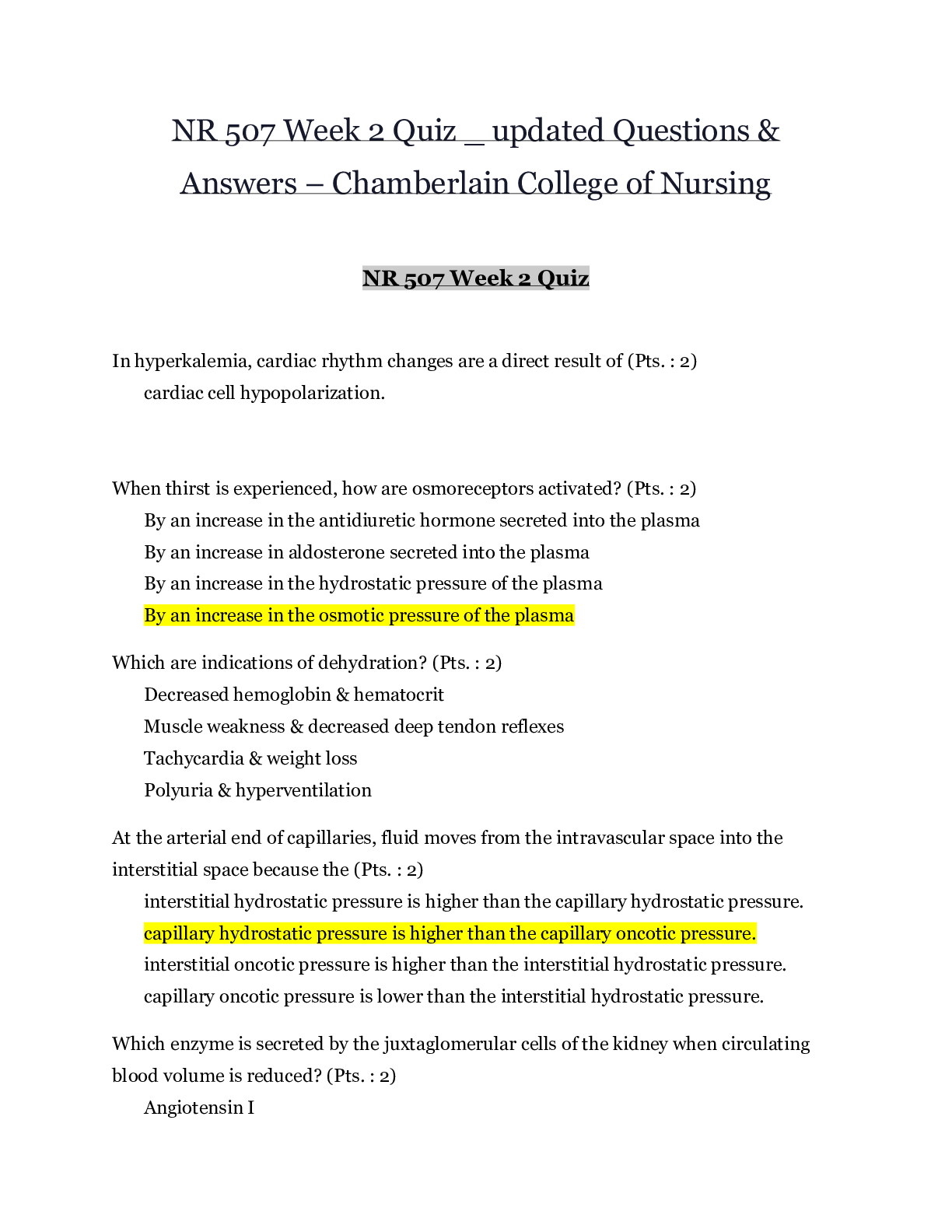
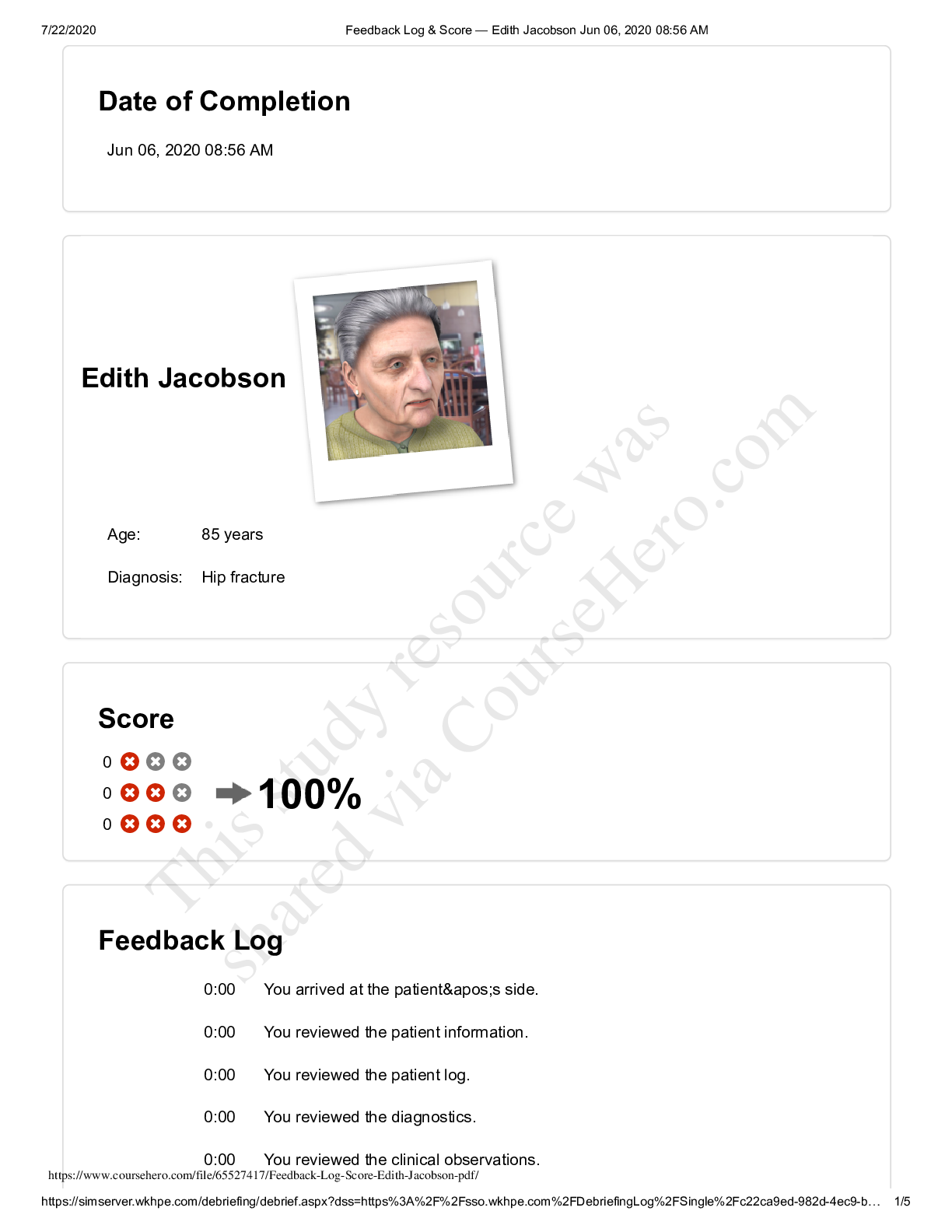
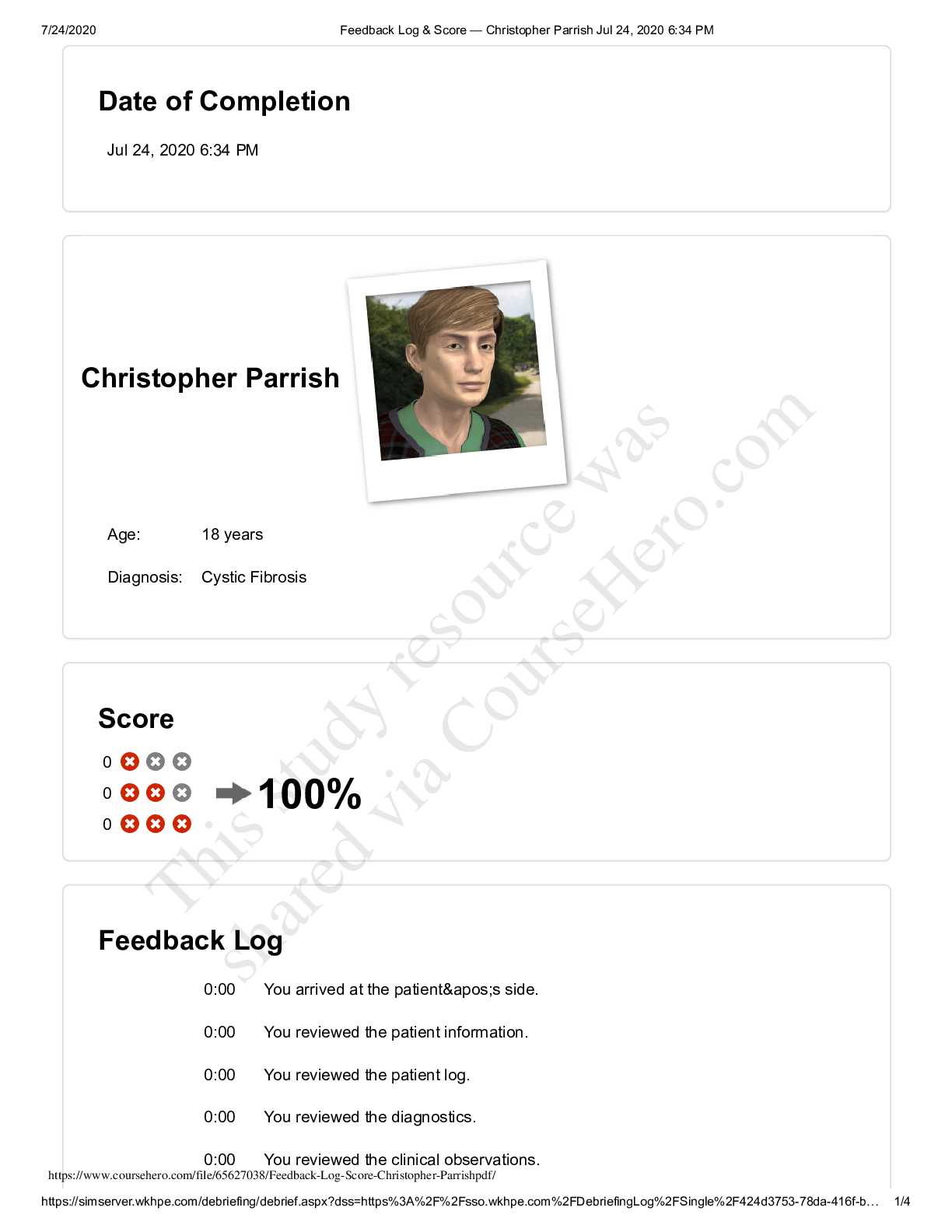
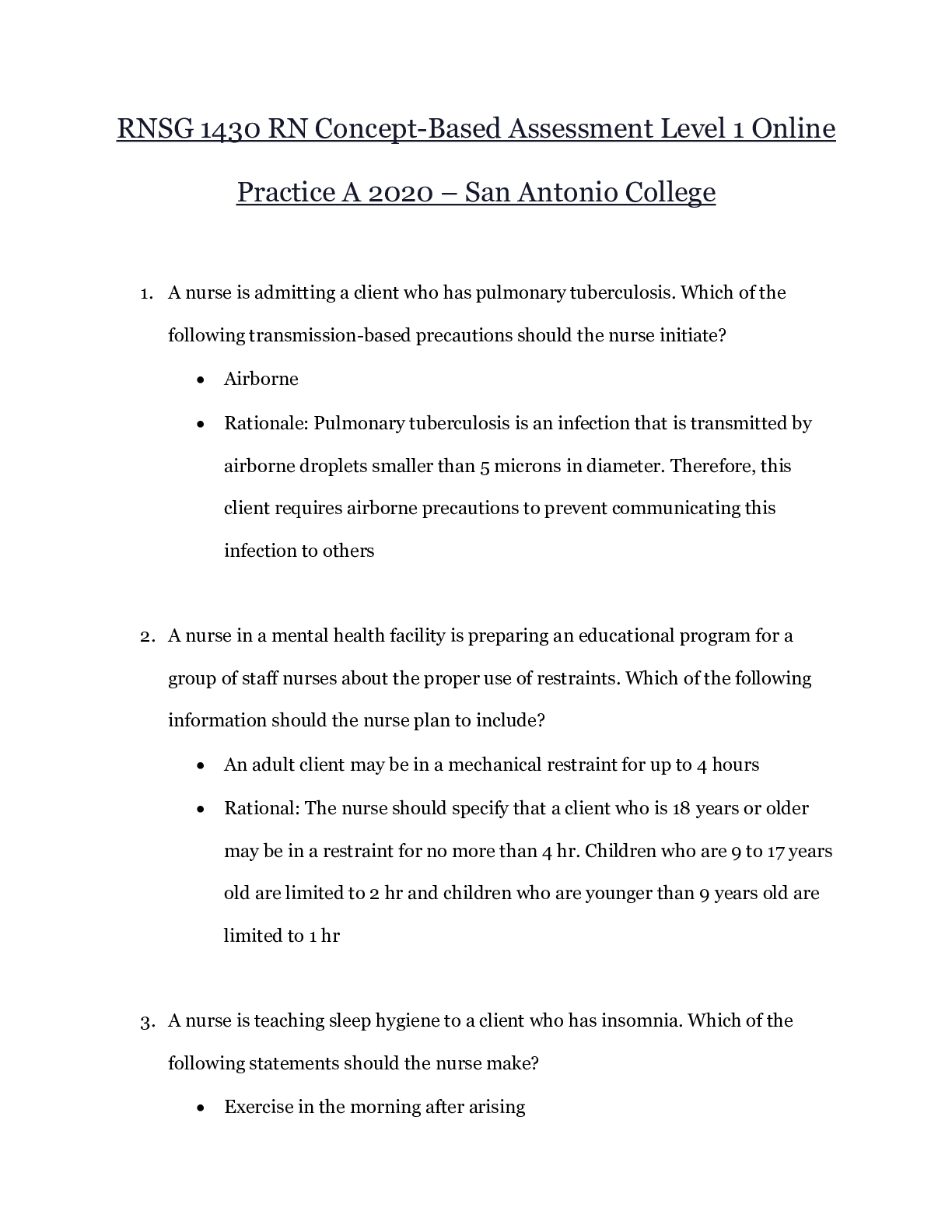


 – CHAMBERLAIN COLLEGE OF NURSING.png)
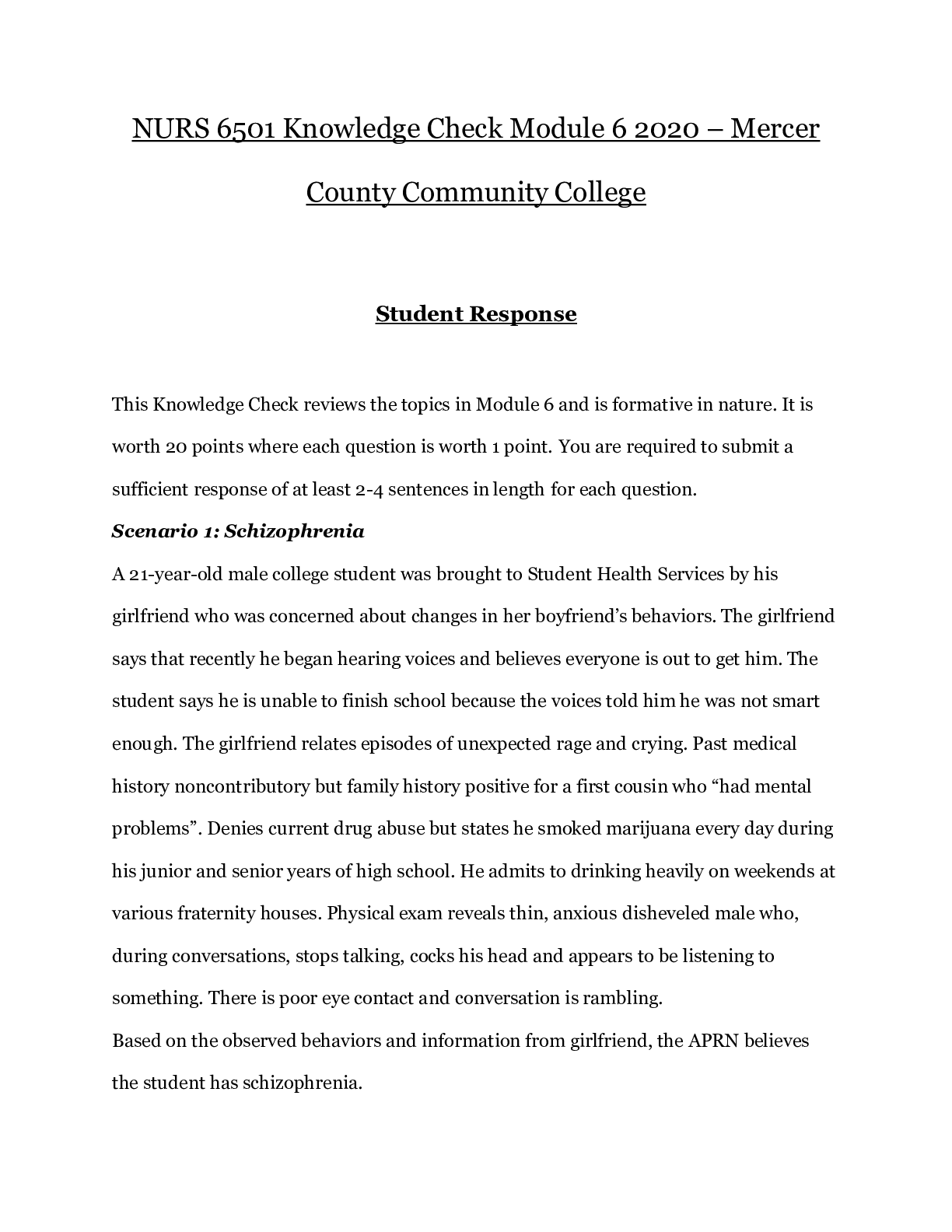
.png)






